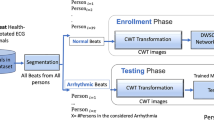Abstract
Personal identification method using the Electrocardiogram (ECG) signal is an active research area since the ECG signal cannot be forged and can be acquired without active awareness by the subject. In this paper, we propose a personal recognition system using the 2-D coupling image of the ECG signal. The proposed system uses the 2-D coupling image generated from three periods of the ECG signal as input data to the network whose design is based on a Convolutional Neural Network (CNN) that is specialized for image processing. Waveform of the 2-D coupling image which is the input data to the network cannot be visually confirmed and it has the advantage of being able to augment the QRS-complex which is a personal unique information. We confirm recognition performance of 99.2% from the experiment result for the proposed personal recognition system using MIT-BIH data.








Similar content being viewed by others
Explore related subjects
Discover the latest articles and news from researchers in related subjects, suggested using machine learning.References
Biel L, Pettersson O, Philipson LPW (2001) Ecg analysis: a new approach in human identification. IEEE Trans Instrum Measurement 50(3):808–812. https://doi.org/10.1109/19.930458
Choi GH, Moon HM, Pan SB (2017) Biometrics system technology trends based on biosignal. J Digit Converg 15(1):381–391
Choi GH, Jung JH, Moon HM, Kim YT, Pan SB (2019) User authentication system based on baseline-corrected ecg for biometrics. Intell Autom Soft Comput 25(1):193–204. https://doi.org/10.31209/2018.100000055
Choi HS, Lee BH, Yoon SR (2016) Biometric authentication using noisy electrocardiograms acquired by mobile sensors. IEEE Access 4:1266–1273. https://doi.org/10.1109/ACCESS.2016.2548519
Chun SY, Kang JH, Kim HV, Lee CH, Oakley I, Kim SP (2016) Ecg based user authentication for wearable devices using short fourier transform. In: International conference on telecommunications and signal processing, pp 656–659. https://doi.org/10.1109/TSP.2016.7760964
Coutinho DP, Silva H, Gamboa H, Fred A, Figueiredo M (2013) Novel fiducial and non-fiducial approaches to electrocardiogram-based biometrics systems. IET Biom 2(2):64–75. https://doi.org/10.1049/iet-bmt.2012.0055
Falconi JSA, Osman HA, Saddik AE (2016) Ecg authentication for mobile devices. IEEE Trans Instrum Measurement 65(3):591–600. https://doi.org/10.1109/TIM.2015.2503863
Goldberger AL, Amaral LAN, Glass L, Hausdorff JM, Ivanov PC, Mark RG, Mietus JE, Moody GB, Peng CK, Stanley HE (2000) Physiobank, physiotoolkit, and physionet: components of a new research resource for complex physiologic signals. Circulation 101(23):215–220
Jahiruzzaman M, Hossain ABMA (2015) Ecg based biometric human identification using chaotic encryption. InL International conference on electrical engineering and information communication technology. https://doi.org/10.1109/ICEEICT20157307417
Karegar FP, Fallah A, Rashidi S (2017) Ecg based human authentication with using generalized hurst exponent. In: Iranian conference on electrical engineering, pp 34–38. https://doi.org/10.1109/IranianCEE.2017.7985480
Kaveh A, Chung W (2013) Temporal and spectral features of single lead ecg for human identification. In: 2013 IEEE workshop on biometric measurements and systems for security and medical application, Naples, Italy, 9 September 2013. IEEE, pp 17–21. https://doi.org/10.1109/BIOMS.2013.6656143
Kim JH, Lee SM, Park KH (2016) Stepwise detection of the qrs complex in the ecg signal. J Korean Inst Commun Sci 41(2):244–253
Kim JS, Pan SB (2017) A study on emg-based biometrics. J Internet Serv Inform Secur 7(2):19–31. https://doi.org/10.22667/JISIS.2017.05.31.019
Kim JS, Choi GH, Pan SB (2017) A study on ecg-based biometrics using open source hardware. Inform Commun Technol Evolution. https://doi.org/10.22667/ReBiCTE.2017.11.15.017
Labati RD, Munoz E, Piuri V, Sassi R, Scotti F (2018) Deep-ecg: convolutional neural networks for ecg biometric recognition. Pattern Recognit Lett. https://doi.org/10.1016/j.patrec.2018.03.028
Lin SL, Chen CK, Lin CL, Yang WC, Chiang CT (2014) Individual identification based on chaotic electrocardiogram signals during muscular exercise. IET Biom 3(4):257–266. https://doi.org/10.1049/iet-bmt.2013.0014
Pan J, Tompkins J (1985) A real-time qrs detection algorithm. IEEE Trans Biomed Eng 32(3):230–236
Pourbabaee B, Patterson MH, Reiher E, Benard F (2018) Deep convolutional neural network for ecg-based human identification. CMBES Proceedings 41
Bousseljot R, Kreiseler ASD (1995) Nutzung der ekg-signaldatenbank cardiodat det ptb uber das internet. Biomedizinische Technik/Biomed Eng 40(s1):317–318. https://doi.org/10.1515/bmte.1995.40.s1.317
Shen TW, Tompkins WJ, Hu YH (2002) One-lead ecg for identity verification. Proc Second Joint 24th Annu Conf Annu Fall Meet Biomed Eng Soc Eng Med Biol 1:62–63. https://doi.org/10.1109/IEMBS.2002.1134388
Taherisadr M, Asnani P, Galster S, Dehzangi O (2018) Ecg-based driver inattention identification during naturalistic driving using mel-frequency cepstrum 2-d transform and convolutional neural networks. Smart Health 9:50–61. https://doi.org/10.1016/j.smhl.2018.07.022
Venkatesh N, Jayaraman S (2010) Human electrocardiogram for biometrics using dtw and flda. In: International conference on pattern recognition, pp 3838–3481. https://doi.org/10.1109/ICPR.2010.935
Wu JJ, Zhang Y (2014) Ecg identification based on neural networks. In: International computer conference on wavelet active media technology and information processing, pp 92–96. https://doi.org/10.1109/ICCWAMTIP.2014.7073368
Zhai X, Tin C (2018) Automated ecg classification using dual heartbeat coupling based on convolutional neural network. IEEE Access 6:27465–27472. https://doi.org/10.1109/ACCESS.2018.2833841
Zhao Z, Yang L, Chen D, Luo Y (2013) A human ecg identification system based on ensemble empirical mode decomposition. Sensors 13(5):6832–3864. https://doi.org/10.3390/s130506832
Acknowledgements
This research was supported by Basic Science Research Program through the National Research Foundation of Korea (NRF) funded by the Ministry of Education (No. 2017R1A6A1A03015496) and the National Research Foundation of Korea (NRF) grant funded by the Korea government (MSIT) (No. NRF-2018R1A2B6001984).
Author information
Authors and Affiliations
Corresponding author
Additional information
Publisher's Note
Springer Nature remains neutral with regard to jurisdictional claims in published maps and institutional affiliations.
Rights and permissions
About this article
Cite this article
Kim, J.S., Kim, S.H. & Pan, S.B. Personal recognition using convolutional neural network with ECG coupling image. J Ambient Intell Human Comput 11, 1923–1932 (2020). https://doi.org/10.1007/s12652-019-01401-3
Received:
Accepted:
Published:
Issue Date:
DOI: https://doi.org/10.1007/s12652-019-01401-3




